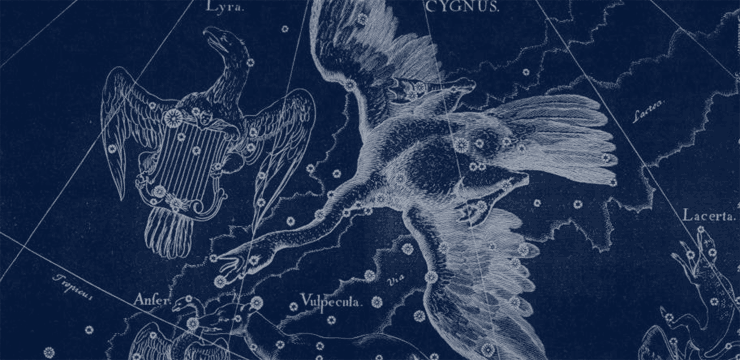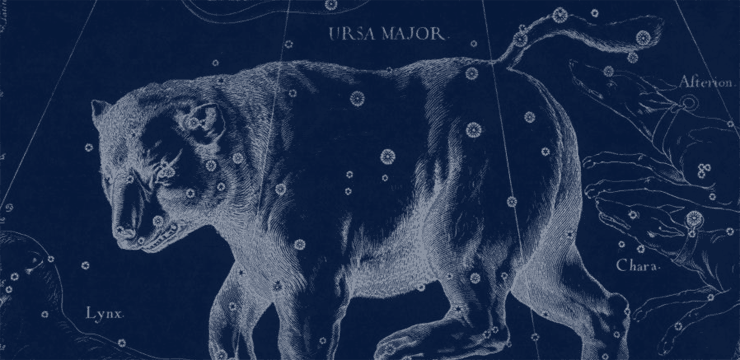
August Contellations & Folklore
August 2011 :
Now that the signpost of summer, the Summer Triangle, is reaching its high position in the sky, it's time to use its stars to find some of the dimmer, but still easy to sight, constellations.
Beginning with Altair, look just to its left, or east. You may see what looks at first to be a small kite, with a long tail. You've actually found Delphinus, the Dolphin. This creature was placed in the sky because of its saving the singer Aryan. Aryan could be compared to whatever giant among singers you want - Frank Sinatra, Elvis Presley, I once had a 10-year-old suggest Eminem. Whatever. Aryan was sailing home after a very successful world tour; unfortunately, his shipmates decided among themselves that Aryan was so successful that he had too much riches for just one person. So, one night, as Aryan was walking the deck, some of them came up behind him and threw him overboard, then stormed his room and divided his wealth among them. Unfortunately for them, waiting at the dock for them was Aryan. It seems his music was so beautiful that not only did people love to hear him, but he had a set of dolphin groupies following the ship, just to listen. Therefore, when he was thrown into the sea, one of the dolphins swam underneath him, and carried him all the way home.
You may have a slight problem seeing this constellation at first, because its stars are all relatively dim, but because they are so close to each other, once you do find it, it will always show itself to you. Your eyes react to Delphinus just like the open star cluster the Pleiades in the winter months; the stars making up this part of the sky are also very dim, but, once you find it, your eyes will always be attracted to this close set of dim stars. Delphinus will do the same for you.
Starting at Vega, and going straight down to Altair, keep following that line until you find two stars rather close to each other; then, keep going until you find two more stars about the same distance to each other as the first two. From the bottom of the second set of stars, move to the left, or east, until you find one more star about the same brightness as the previous four. Once there, make a line back to the top of the first two stars. You may notice you've made a pretty good sail shape. Actually, you've found Capricornus, the Sea-Goat. Legend has this constellation representing Pan, who spent much of his time making peoples' lives miserable. He did, however, have the amazing ability to morph himself into any shape he wanted. One afternoon, Pan changed himself into a goat, and spent the day prancing around the forest. Suddenly, he heard a commotion behind him, and Pan realized he was being chased by people who were looking for him - some say he owed them a lot of money. Pan started to run as fast as he could, but goats aren't known to sprint very fast, and his followers were catching up to him. As Pan looked ahead of him, he noticed he was approaching a river. He immediately decided to change himself into a fish, jump into the water, and swim away from danger. But, as he was jumping into the river, he realized he hadn't morphed completely into a fish; his legs had turned into a fishtail, but his front was still a goat as his body dove underwater.
In a dark sky, you might be able to see the Milky Way splitting the triangle in half, from upper right - near Deneb, the Swan's tail - to lower left, by Altair. If not, just move your eyes downward, through the triangle, and continue until you note a shape looking a lot like your kitchen teapot. This is actually the asterism the Teapot, the major part of Sagittarius, the Archer. Sagittarius was placed in the sky as a guardian to the scorpion, located right next door, to the archer's right, or west. Scorpius is credited with killing Orion, who boasted he would kill all the animals in the world. After being placed up in the sky, there were some animals who weren't sure If the scorpion might decide to come back to Earth, so Sagittarius is ready, with his bow in position, if Scorpius moves. If so, the arrow will land directly in the scorpion's heart, and the Earth will be safe from a killer arachnoid.
Sagittarius is one of two centaurs in the sky, but for us in the Northern Hemisphere, it's the only one we can observe. The other, Centaurus, is waiting for you if you cruise around the Caribbean, or points south. But Sagittarius is a very important part of our sky. Once you find it, you may notice it doesn't rise very high in our sky; in fact, the rest of the actual constellation, the centaur's legs, never rises above our horizon. But, if you can identify the spout, you can, in a dark sky, note the teapot actually seems to have steam rising from its spout. At that position in the constellation, you've found the direction of the center of the Milky Way, our home galaxy.
Sagittarius is the part of the sky where the Sun rises out of the eastern horizon at its most southeasterly position (and, consequently sets most southwesterly). It does so on December 21st. At that point, although we can't see the constellation because the Sun is then located in it, we mark the beginning of the season of winter.
When to Observe
Constellations
Related Topics




